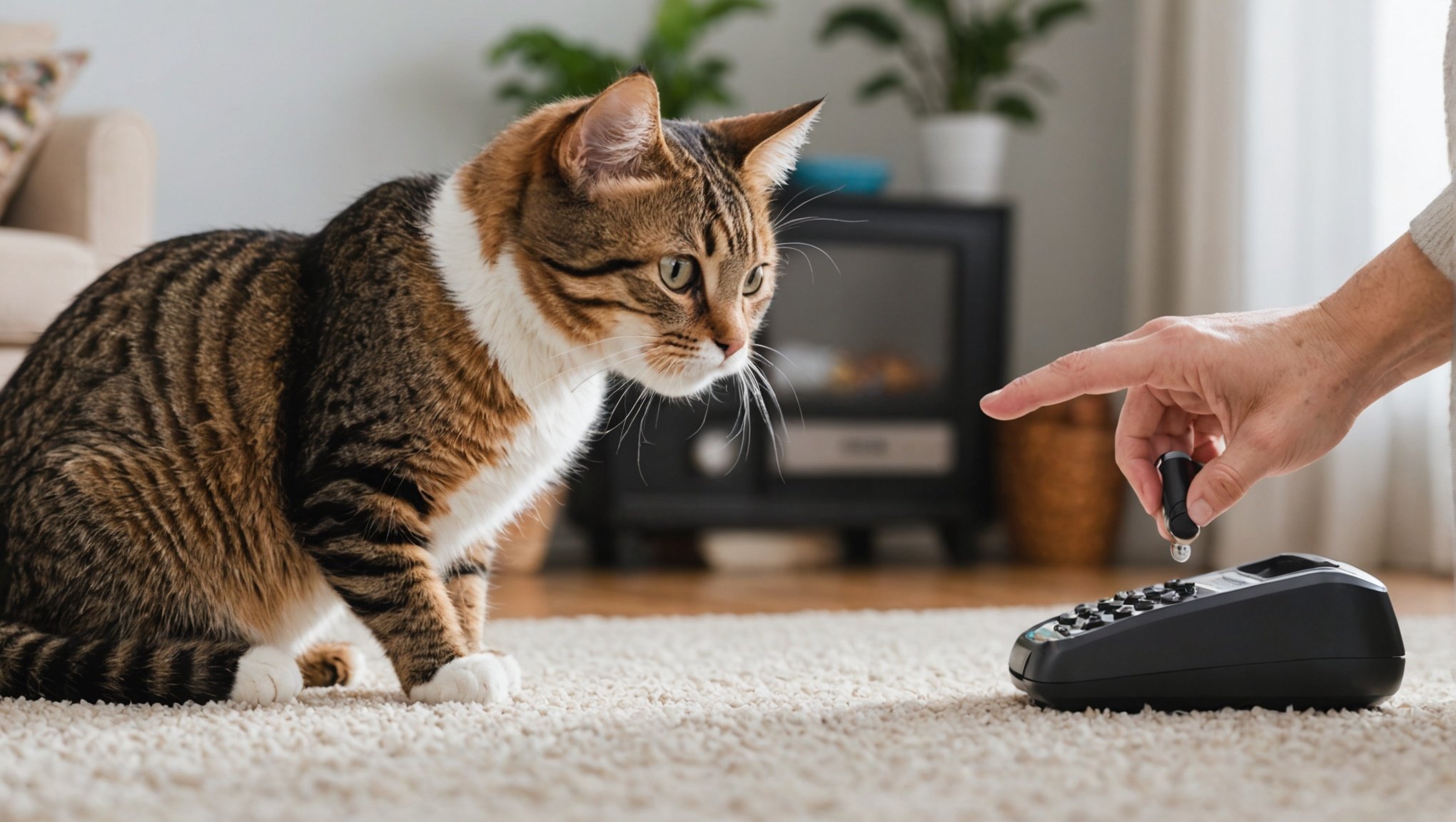Transforming your cat’s behavior can feel daunting, but with clicker training, you can achieve positive changes seamlessly. This innovative method not only reinforces desired behaviors but also enhances your bond with your feline friend. By incorporating clicker training into daily routines, you create an enriching environment that encourages learning and growth. Discover how small, manageable steps can lead to significant improvements in your cat’s behavior—making life more enjoyable for both of you.
Understanding Clicker Training for Cats
Clicker training is a method of animal training that uses a sound—a “click”—to mark a desired behavior. This technique is rooted in positive reinforcement, where the click is immediately followed by a reward, such as a treat. The click serves as a clear and consistent signal to the cat that it has done something right. Over time, this approach can effectively shape cat behavior, encouraging them to repeat actions that are rewarded.
A lire en complément : Selecting the Perfect Cat Carrier for Vet Trips and Travel: A Guide Tailored to Your Cat”s Size and Personality
The origins of clicker training can be traced back to the mid-20th century when it was initially developed for training marine mammals. Its success in that realm led to its adaptation for domestic animals, including cats. The method’s simplicity and effectiveness have contributed to its widespread adoption in pet training.
The benefits of clicker training for cats are numerous. It can enhance communication between the owner and the pet, making it easier to teach commands and tricks. This method also strengthens the bond between cat and owner, as it fosters an environment of trust and cooperation. Moreover, clicker training can address and modify unwanted behaviors, providing a structured way to guide cats toward more desirable actions.
Cela peut vous intéresser : Gentle Ways to Train Your Cat to Tolerate Nail Clipping Without Stress or Restraint
Preparing for Clicker Training
Before embarking on clicker training with your cat, it’s essential to set the stage for success. Selecting the right clicker tools is your first step. A clicker should be easy to handle and produce a clear, consistent sound. Some clickers come with adjustable volumes, which can be beneficial depending on your cat’s sensitivity to sound.
Equally important is choosing the right treats. Opt for small, soft, and highly palatable treats that your cat loves. This will ensure that the reward is immediate and satisfying, reinforcing the desired behavior effectively.
Creating a distraction-free training environment is crucial. Choose a quiet space where your cat feels safe and is less likely to be disturbed by noises or other pets. This will help your cat focus on the training session and respond better to the clicker cues.
Assessing your cat’s readiness is also vital. Ensure your cat is alert, healthy, and not stressed before starting a session. A relaxed and comfortable cat is more likely to engage positively with training. Pay attention to your cat’s body language and energy levels to gauge their comfort and willingness to participate.
Step-by-Step Guide to Clicker Training
Embarking on clicker training with your cat involves understanding the key training steps and clicker techniques. This method is not only about teaching tricks but also about effective behavior modification.
Getting Started with Basic Commands
Begin with simple commands, such as “sit” or “come.” Use the clicker to mark the exact moment your cat performs the desired action. Precision is crucial here. Once the action is marked, promptly reward your cat with a treat. This reinforces the behavior and helps your cat associate the click with a positive outcome.
Reinforcing Positive Behaviors
Consistency in clicker usage is vital. Ensure that every time your cat exhibits the desired behavior, it is immediately followed by a click and a treat. This repetition solidifies the connection between the action and the reward. Over time, your cat will understand that positive behaviors lead to treats, encouraging them to repeat these actions.
Increasing Complexity in Training
As your cat becomes accustomed to basic commands, gradually introduce more complex behaviors. This could include commands like “stay” or “fetch.” Maintain the same level of precision and consistency with the clicker. By slowly increasing the complexity, you challenge your cat while keeping the training engaging and rewarding.
Daily Integration of Clicker Training
Incorporating clicker training into your cat’s daily routine can be a seamless process that enhances both the training experience and your bond with your pet. Establishing habit formation is key to successful training outcomes.
Setting a Consistent Training Schedule
Consistency is crucial. Designate specific times each day for training sessions. This regularity helps your cat anticipate and look forward to these interactions. A structured training schedule not only maintains your cat’s interest but also reinforces learned behaviors more effectively.
Making Training Fun and Engaging
Training should be a fun and engaging experience for both you and your cat. Incorporate playful elements to keep sessions lively. Use toys or interactive games as part of the training, ensuring your cat remains enthusiastic. This approach helps integrate training into your cat’s daily life naturally, making it a positive part of their routine.
By embedding training into daily activities, you create a dynamic environment where learning is continuous and enjoyable. This strategy not only aids in habit formation but also strengthens the trust and communication between you and your feline friend.
Examples of Positive Behavior Changes
Clicker training can lead to significant behavior changes in cats, making it a popular choice for pet owners seeking effective training outcomes. By focusing on behavior examples that are commonly modified, we can understand the potential of this approach.
Commonly Modified Behaviors
Clicker training is particularly effective for addressing behaviors such as scratching furniture, excessive meowing, and not using the litter box. By consistently marking and rewarding desired actions, these behaviors can be redirected towards more acceptable alternatives. For instance, a cat that scratches furniture may be trained to use a scratching post instead.
Success Stories
There are numerous success stories where clicker training has transformed pet behavior. One notable case involves a cat named “Whiskers,” who was notorious for jumping on kitchen counters. Through consistent clicker training, Whiskers learned to stay off the counters, significantly reducing stress for her owner.
Tracking Progress
Visualizing progress is crucial for maintaining motivation. Pet owners can track and record behaviors to monitor improvements over time. Keeping a log of training sessions and outcomes helps in identifying patterns and areas needing more focus. This structured approach enhances the effectiveness of clicker training, leading to lasting behavior changes.
Addressing Challenges in Clicker Training
Clicker training is an effective method for shaping cat behavior, but it can come with its own set of training obstacles. Understanding these challenges and how to overcome them is crucial for successful outcomes.
Common Challenges and Solutions
One of the primary training obstacles is inconsistency in reinforcement, which can lead to confusion and slow progress. It’s essential to maintain a consistent reward system. Another challenge is behavior issues that persist despite training efforts. In such cases, reassessing the training approach and possibly consulting a professional trainer might be beneficial.
Dealing with Distractions
Cats are naturally curious, making distractions a significant hurdle during training. To minimize these, choose a quiet environment and keep training sessions short. If external noises or activities interrupt, gently redirect your cat’s attention back to the task.
Maintaining Cat Engagement
Keeping your cat motivated is vital for effective clicker training. Use a variety of treats and toys to maintain interest. Regularly changing the rewards can prevent your cat from becoming bored. Additionally, ensure sessions are fun and interactive, fostering a positive association with training.
Enhancing Clicker Training with Visual Aids
Incorporating visual aids into clicker training can significantly enhance both the trainer’s and the cat’s understanding of the process. Training videos and tutorials serve as excellent resources for learning. They provide clear demonstrations of techniques, making it easier to grasp complex concepts. Watching these videos allows trainers to observe the nuances of timing and reward delivery, crucial for effective training.
Creating visual guides and charts can further aid in tracking progress. By documenting each training session, owners can identify patterns and areas of improvement. These instructional materials offer a tangible way to measure success and adjust strategies as needed. Visualizing progress not only boosts motivation but also ensures a structured approach to training.
The benefits of visual learning are well-documented. It reinforces training concepts by offering a different perspective. For cats, visual cues can be integrated as part of the training routine. Simple gestures or signals can complement the clicker, providing an additional layer of communication. This multi-sensory approach caters to various learning styles, making the training more engaging and effective. By leveraging visual aids, trainers can enhance their methods, leading to more successful and enjoyable training experiences.
Real-Life Scenarios for Clicker Training
Clicker training offers practical applications in numerous everyday situations, making it a versatile tool for cat owners. By exploring different training scenarios, you can adapt techniques to suit various environments and encourage behavioral adjustments.
Exploring Everyday Situations
Incorporating clicker training into daily life can be seamless. For instance, use clicker cues to manage feeding times. By clicking when your cat waits patiently for food, you reinforce calm behavior. This technique can also be applied to grooming sessions, where the clicker marks moments of cooperation, easing stress for both cat and owner.
Adapting to Various Environments
Training isn’t limited to home settings. During vet visits, a familiar clicker sound can comfort your cat, reducing anxiety. Similarly, when introducing your cat to new environments, like a friend’s home or a pet-friendly café, clicker training helps maintain familiar routines, promoting confidence and reducing stress.
Encouraging Good Behavior
Clicker training is effective during playtime. Rewarding your cat for using toys instead of furniture encourages appropriate play. Additionally, during social interactions with other pets or people, clicker cues can promote polite behavior, fostering positive relationships. By integrating clicker training into these typical activities, you create a harmonious living environment.
Resources for Continued Learning
Exploring clicker training for cats can be a rewarding journey, and there are numerous training resources available to deepen your understanding.
Recommended Books and Articles
Diving into further reading can provide valuable insights. Consider books like “Clicker Training for Cats” by Karen Pryor, which offers expert advice on techniques and strategies. Articles in pet magazines and websites often feature tips and success stories, providing a wealth of knowledge to enhance your training approach.
Online Courses and Workshops
For a more structured learning experience, online courses offer comprehensive modules on clicker training. Websites such as Udemy and Coursera provide workshops led by experienced trainers, covering everything from basic commands to advanced techniques. These courses are designed to accommodate different learning paces, ensuring a thorough understanding of the method.
Community Support and Forums
Engaging with community support can be invaluable. Forums like Reddit and Facebook groups dedicated to cat training allow you to connect with other cat owners. Sharing experiences and advice in these spaces fosters a sense of camaraderie and provides diverse perspectives on tackling training challenges. Active participation in such communities can significantly enhance your training journey.
















